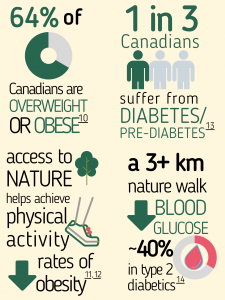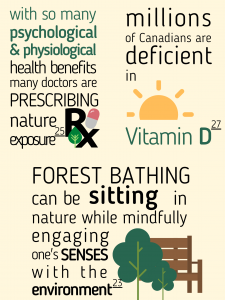Expandable List
Over 64% of Canadian are overweight or obese10 and research suggests that those living near greenspaces are more likely to achieve physical activity recommendations and less likely to be obese11,12. Furthermore, Diabetes and prediabetes impact nearly 1/3 canadians and although exercise is known to help mitigate this condition, nature exposure may have an added metabolic effect13. A study of type 2 diabetic patients found that a forest walk of 3+ km decreased blood glucose levels significantly more than equivalent indoor exercise suggesting that the forest environment offers further benefits in reducing blood glucose levels in diabetic patients14.
Both stress reduction and exposure to therapeutic chemicals called phytoncides are thought to contribute to the physical health benefits of nature15. Phytoncides are essential oils emitted by trees which are thought to have a biological effect on stabilizing blood pressure and decreasing sympathetic nervous system activation16,17. In a more recent study of non-diabetic individuals, nature walks did not significantly impact blood glucose levels but showed a beneficial effect on serum adiponectin which may have a protective effect against several metabolic disorders18.
These benefits of spending time in nature compared to urban settings also play a role in improving cardiovascular health. Heart disease is the second leading cause of death in Canada19, and nature walks have also demonstrated the ability to decrease blood pressure, regulate pulse and lower adrenaline levels among those with hypertension20.
With significant overlap with other metabolic conditions, these cardiovascular benefits of nature exposure are thought to be tied to the direct chemical effects of phytoncides in addition to the indirect effects of stress-reduction and physical activity.
Physiologically, nature is also thought to improve immune function. Both living close to greenspaces and participating in forest bathing trips have been associated with increased activity of natural killer cells and increased circulating angiogenic cell capacity21,22. These results suggest that nature exposure can have positive effects on tumour mitigation and virus prevention as well as wound healing and blood vessel repair.
Nature bathing, a traditional Japanese practice of immersing oneself in nature by mindfully using all five senses, demonstrates many of the direct health benefits of nature23. However, there are also many indirect benefits related to physical activity and social connection that can come from getting outside24. With these combined benefits in mind, many healthcare professionals are recommending patients get in nature more to promote a holistic healthy lifestyle25. Importantly as an affordable health promotion activity, access to nature may play a role in improving health equity by overcoming the impacts of certain social determinants of health26.
Additionally in Canada, Vitamin D insufficiency is common. Required for calcium absorption, Vitamin D is not only critical for bone health, it is also thought to play a role in the prevention of other chronic illnesses such as diabetes, cardiovascular disease27. Getting outside and in nature can help Canadians overcome this deficiency and improve public health.












